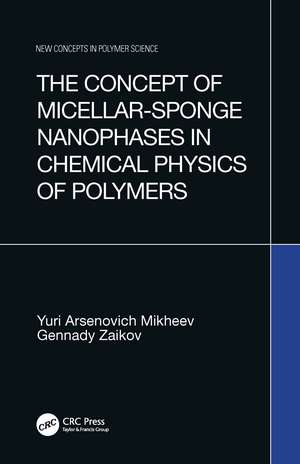The Concept of Micellar-Sponge Nanophases in Chemical Physics of Polymers
Autor Yuri Arsenovich Mikheev, Gennady Zaikoven Limba Engleză Hardback – apr 2004
Preț: 1220.88 lei
Preț vechi: 3028.20 lei
-60% Nou
Puncte Express: 1831
Preț estimativ în valută:
233.69€ • 253.92$ • 196.43£
233.69€ • 253.92$ • 196.43£
Carte indisponibilă temporar
Doresc să fiu notificat când acest titlu va fi disponibil:
Se trimite...
Preluare comenzi: 021 569.72.76
Specificații
ISBN-13: 9789067644020
ISBN-10: 9067644021
Pagini: 450
Dimensiuni: 156 x 234 mm
Greutate: 0.8 kg
Ediția:1
Editura: CRC Press
Colecția CRC Press
ISBN-10: 9067644021
Pagini: 450
Dimensiuni: 156 x 234 mm
Greutate: 0.8 kg
Ediția:1
Editura: CRC Press
Colecția CRC Press
Public țintă
This monograph is of value and interest to students, postgraduates and scientists searching for new properties of polymers for applied purposes.Cuprins
PREFACE CHAPTER I. INTRODUCTION. THE PROBLEM OF STRUCTURAL-PHYSICAL ORGANIZATION OF POLYMERIC NON-CRYSTALLINE PHASE CHAPTER2. STRUCTURAL MODEL OF NON-CRYSTALLINE POLYMERIC MATRIX CHAPTER 3. SUPRAMOLECULAR ASPECTS OF NCPM CHEMICAL PHYSICS CHAPTER 4. KINETIC PROBING OF NCPM GLASSY-LIKE POLYMERS WITH THE HELP OF DIBENZOYL PEROXIDE CHAPTER 5. KINETIC MODEL OF DIBENZOYL PEROXIDE CHAIN REACTION WITH STERICALLY HINDERED PHENOLS CHAPTER 6. DIBENWYL PEROXIDE KINETIC PROBING OF MELT AND RUBBERY POLYMERS CHAPTER 7. THE EXAMPLES OF HETERO-NANOPHASE KINETIC DESCRIPTION OF PHOTOCHEMICAL REACTIONS
Notă biografică
Yuri Arsenovich Mikheev, Gennady Zaikov, N.M Emanuel Institute of Biochemical Physics, Moscow, Russia.
Descriere
This monograph deals with the novel concept of chemical physics concerning polymer non-crystalline phase. In the phase supramolecular model created, a small share of polymeric chains of bulky non-crystalline polymers is assembled in paracrystalline domains, which form continuous cellular carcass. Inside the carcass cells, polymeric chains form nanoporous spongy micelles. The functions of the micelles regarding their physical interactions with low molecular compounds and their behavior in chemical chain reactions are described. This monograph is of value and interest to students, postgraduates and scientists searching for new properties of polymers for applied purposes.
